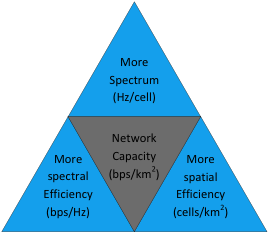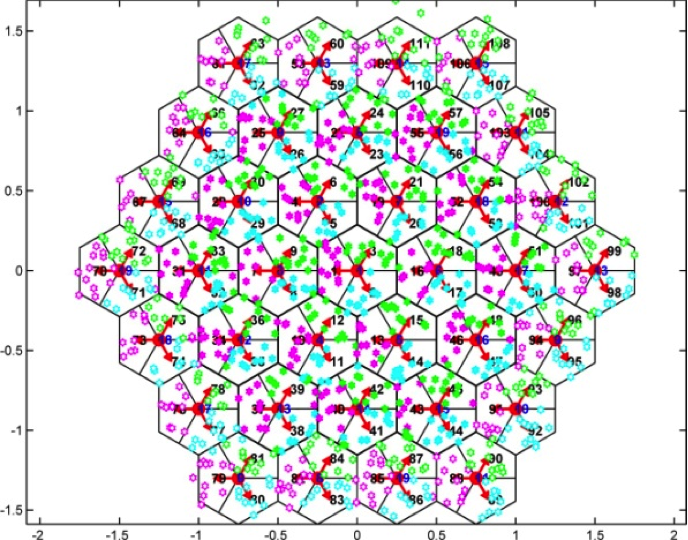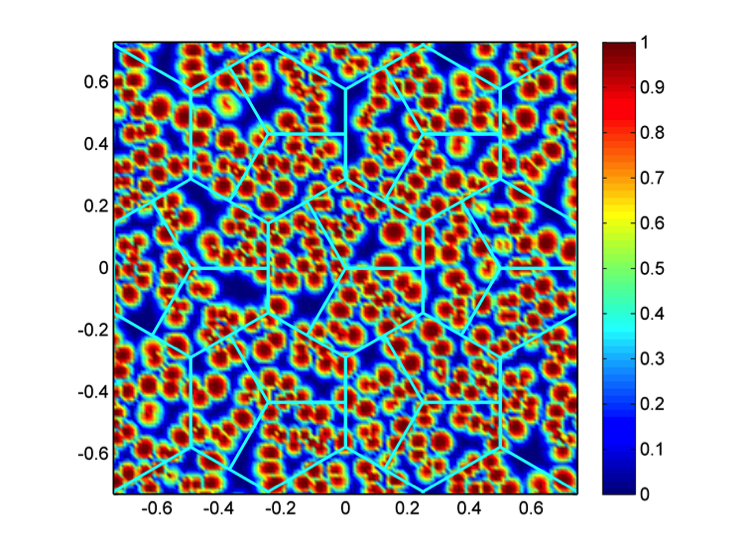5G Networks
In the next 20 years, wireless communication systems will face three major challenges, which are data traffic explosion, rise of the mobile Internet, and a gigantic number of upcoming machine-to-machine (M2M) devices. These challenges pose a lot of new requirements for the existing 4th generation (4G) networks. Therefore, the development of modern wireless communication system has entered the enhanced 4G era and began to gradually move toward the 5th generation (5G) front. Higher data rate and better quality of service will continue to be the focal points of research activities both in academic and industrial fields.
Regarding the 5G networks, the mobile industry has set its targets high, and has decided to improve the capacity of today’s networks by a factor of 100 or more over the next 20 years – 1000 the most ambitious. In order to achieve this goal, vendors and operators are currently looking at using every tool they have at hand, where the existing tools can be classified within the following three paradigms as illustrated in Fig. 1.
- Enhance spatial reuse through network densification, i.e., Heterogeneous Networks (HetNets) and small cells.
- Use of larger bandwidths, exploiting higher carrier frequencies, both in licensed and unlicensed spectrum.
- Enhance spectral efficiency through multi-antenna transmissions, cooperative communications, dynamic TDD techniques, etc.
Existing paradigms to improve network capacity: more spectrum, more spectral efficiency and more spatial efficiency
This toolbox provides vendors and operators with choice and flexibility to improve network capacity, but leads to new enigmas on how each operator should make the investment to meet the capacity demands. Different operators with different financial means, customer market segmentation, existing network assets and technical expertise should require different solutions. Network densification complicates network deployment as well as backhauling and mobility management, while higher carrier frequencies suffer from larger path losses, and usually require more expensive equipment. Most spectral efficiency enhancement technologies depend on a tight synchronization as well as relatively complex signal processing capabilities, and may be compromised due to inaccuracies in Channel State Information (CSI). Capital Expenditure (CAPEX) and Operational Expenditure (OPEX) are also major concerns since the price per bit should be kept at minimum. To make things more complex, network deployments strategies should consider that these three paradigms have their own fundamental limitations and thus cannot be infinitely exploited. Finding the right portfolio of tools to meet the key requirements is vital for both vendors and operators in the current financial climate.
Objective
To shed new light on the Pareto set of network configurations in terms of small cell density, frequency band of operation and number of antennas per small cell Base Station (BS) that can meet future traffic demands, achieving an average throughput exceeding 1 Gbps per UE.
Research topics
- Ultra-dense small cell networks
- Coexistence of cellular networks and Wi-Fi networks
- High frequency communications
- Dynamic TDD / full duplexing systems
- Cooperative communications
Approach
- System-level computer simulations
- Theoretical analysis based on stochastic geometry
Illustration of system-level simulations.
Illustration of theoretical analysis based on stochastic geometry.
Collaborations
- Bell Labs, Dublin, Ireland
Recent publications
- Ming Ding, David López Pérez, Guoqiang Mao, and Zihuai Lin, “Microscopic Analysis of the Uplink Interference in FDMA Small Cell Networks,” submitted to IEEE Transactions on Wireless Communications (Minor Revision), arXiv:1508.02808 [cs.NI], Aug. 2015.
- Ming Ding, Peng Wang, David López Pérez, Guoqiang Mao, and Zihuai Lin, “Performance Impact of LoS and NLoS Transmissions in Dense Cellular Networks,” to appear in IEEE Transactions on Wireless Communications, arXiv:1503.04251 [cs.IT], Dec. 2015.
- Ming Ding, David López Pérez, Guoqiang Mao, and Zihuai Lin, “DNA-GA: A New Approach of Network Performance Analysis,” to appear in IEEE ICC 2016, arXiv: 1512.05429 [cs.IT], Dec. 2015.
- Tian Ding, Ming Ding, Guoqiang Mao, and Zihuai Lin, David López Pérez, “Uplink Performance Analysis of Dense Cellular Networks with LoS and NLoS Transmissions,” to appear in IEEE ICC 2016, Oct. 2015.
- Ming Ding, David López Pérez, Guoqiang Mao, and Zihuai Lin, “Approximation of Uplink Inter-Cell Interference in FDMA Small Cell Networks,” IEEE Globecom 2015, arXiv: 1505.01924 [cs.NI], Dec. 2015.
- Ming Ding, David López Pérez, Guoqiang Mao, Peng Wang, and Zihuai Lin, “Will the Area Spectral Efficiency Monotonically Grow as Small Cells Go Dense?,” IEEE Globecom 2015, arXiv: 1505.01920 [cs.NI], Dec. 2015.
- Zhe Luo, Ming Ding, Hanwen Luo, “CC On/Off Scheduling Using Learning-Based Prediction for LTE in the Unlicensed Spectrum,” IEEE Communications Letters, vol. 19, no. 12, pp. 2158-2161, Dec. 2015.
- Amir Jafari, David López Pérez, Ming Ding, and Jie Zhang, “Study on Scheduling Techniques for Ultra Dense Small Cell Networks,” IEEE Vehicular Technology Conference (VTC), Boston, USA, pp. 1-6, Sep. 2015.
- David López Pérez, Ming Ding, Holger Claussen, and Amir Jafari, “Towards 1 Gbps/UE in Cellular Systems: Understanding Ultra-Dense Small Cell Deployments,” IEEE Communications Surveys and Tutorials, vol. 17, no. 4, pp. 2078-2101, Jun. 2015.
- Ming Ding, Meng Zhang, David López Pérez, and Holger Claussen, “Correlated shadow fading for cellular networks system-level simulations with wrap-around,” IEEE International Conference on Communications, London, UK, pp. 2245-2250, Jun. 2015.
- Yi Qin, Ming Ding, Meng Zhang, Hui Yu, Hanwen Luo, “Relaying Robust Beamforming for Device-to-Device Communication with Channel Uncertainty,” IEEE Communications Letters, vol. 18, no. 10, pp. 1859-1862, Oct. 2014.
- Zhe Luo, Ming Ding, Hanwen Luo, “Energy Efficient Dynamic Small Cell On/Off Scheduling Using Stackelberg Game,” IEEE Communications Letters, vol. 18, no. 9, pp. 1615-1618, Sep. 2014.
Recent activities
- Ming Ding served as the Tutor of the IEEE International Communication Conference (ICC) Tutorial on “Understanding Small Cell Networks: The Present and The Future” in 2016.
- Ming Ding served as the Leading chair of the 7th IEEE Globecom Workshop on Heterogeneous and Small Cell Networks in 2015.(https://sites.google.com/site/hetsnets2015/)
- Ming Ding served as the Tutor of the IEEE Globecom Tutorial on “Ultra-Dense Small Cell Networks: Theory and Deployment” in 2015.
- Ming Ding served as the Guest Editor of the IEEE Journal on Selected Areas in Communications special issue on Recent Advances in Heterogeneous Cellular Networks in 2014-2015.(https://sites.google.com/site/jsachcn2015/)
- Ming Ding served as the Co-chair of the 6th IEEE Globecom Workshop on Heterogeneous and Small Cell Networks in 2014.(https://sites.google.com/site/hetsnets2014/)



